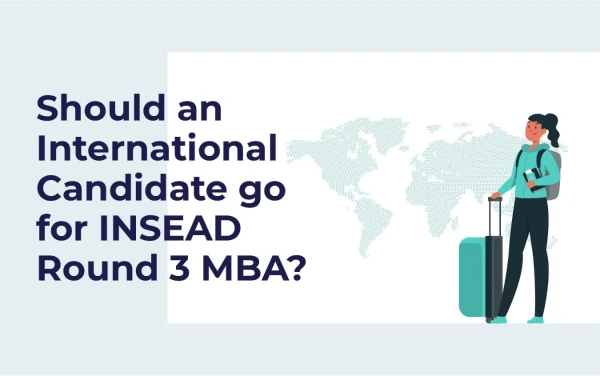Get Into Top MBA Programs: Low GMAT MBA Admissions Tips

Is your GMAT score holding you back from applying to your dream MBA program? Many students believe that a low GMAT score can end their chances of getting into a top business school. But that’s far from the truth. Today, low GMAT MBA admissions are not only possible — they’re becoming increasingly common, thanks to holistic evaluation processes and strategic storytelling.
In this post, we’ll dive into real success stories of applicants who defied the odds and gained MBA admissions into elite programs with low GMAT like INSEAD and Imperial College even with GMAT scores as low as 640. You’ll learn how they did it, what they focused on, and how you can do the same.
If you’re aiming for admissions in Top MBA programs even with low GMAT score, this guide will show you how to transform your perceived weakness into a standout strength — using smart strategy, narrative, and profile-building tactics.
The Reality of Low GMAT Scores in MBA Admissions
Let’s get one thing straight: A low GMAT score does not automatically disqualify you from a top-tier MBA program.
Most business schools — including INSEAD, LBS, and other global giants — publish a range of accepted scores rather than a rigid cutoff. That’s because MBA admissions teams are increasingly focused on complete applicant evaluation.
“Imagine you’re starting a race from behind the line — that’s what it’s like applying with a low GMAT. But the rest of your profile is what helps you not just catch up but stand out.” — MBA Applicant, admitted to Imperial College with a 640 GMAT
The key is understanding that while a low GMAT may place you behind on one metric, it opens the door for you to shine brighter in other areas — such as leadership experience, work accomplishments, and personal drive.
And remember, schools aren’t just admitting test scores. They’re admitting future leaders.
What Matters More Than Your GMAT Score
While the GMAT is a significant component of your MBA application, it’s not the sole determinant of your admission prospects. Admissions committees adopt a overall approach, evaluating various facets of your profile to gauge your potential for success in their programs.
Key Factors Beyond GMAT:
- Professional Achievements: Demonstrated career progression, impactful projects, and notable accomplishments can significantly bolster your application.
- Leadership Roles: Evidence of leadership, whether through managerial positions, team lead roles, or spearheading initiatives, showcases your ability to contribute meaningfully to the program and beyond.
- Academic Performance: A strong undergraduate GPA, especially in rigorous courses, can offset a lower GMAT score.
- Extracurricular Involvement: Active participation in community service, clubs, or other organizations reflects a well-rounded personality and commitment to broader societal contributions.
According to a survey, GMAT scores account for approximately 21.7% of admission decisions, with undergraduate GPA, work experience, and interviews also playing crucial roles.
Moreover, some applicants have secured admission to top programs with GMAT scores below the average range, emphasizing the importance of a comprehensive and compelling application.
How to Build a Strong MBA Profile with a Low GMAT
Watch: Real Strategies to Build a Powerful MBA Profile Without a High GMAT
A lower GMAT score necessitates a strategic approach to highlight other strengths in your application. Here are actionable steps to enhance your profile:
- Pursue Relevant Certifications:
- Obtaining certifications in areas like finance, data analytics, or project management can demonstrate your commitment to continuous learning and proficiency in essential skills.
- Highlight Quantitative Skills:
- Emphasize experiences that showcase your analytical abilities, such as managing budgets, analyzing data trends, or overseeing financial projects.
- Secure Strong Recommendations:
- Choose recommenders who can attest to your professional achievements, leadership qualities, and potential for success in an MBA program.
- Craft a Compelling Personal Statement:
- Articulate your career goals, motivations for pursuing an MBA, and how the program aligns with your aspirations.
- Demonstrate Impact:
- Provide concrete examples of how your contributions have led to positive outcomes in your organization or community.
By focusing on these areas, you can present a well-rounded application that compensates for a lower GMAT score and aligns with the integrated evaluation criteria of top MBA programs.
Want to pursue an MBA but not sure if your profile fits?
Talk to our Profile Experts to know your chances for a top MBA Program.
GET A FREE PROFILE ANALYSISCrafting Your Personal MBA Narrative
A compelling personal narrative can significantly bolster your MBA application, especially when your GMAT score is below the average range. Admissions committees seek candidates who present a clear, coherent story that aligns their past experiences with their future aspirations.
Key Elements to Focus On:
- Career Progression: Detail your professional journey, highlighting promotions, increased responsibilities, and significant achievements. This demonstrates growth and readiness for advanced management education.
- Leadership and Initiative: Provide examples where you’ve led teams, initiated projects, or influenced organizational change. Such instances showcase your potential to contribute meaningfully to the MBA community and beyond.
- Alignment with Program Values: Research each target school’s culture and values. Articulate how your goals and values resonate with the program’s mission, illustrating a strong fit.
- Clarity of Post-MBA Goals: Clearly define your short-term and long-term career objectives. Explain how the MBA program will bridge the gap between your current experience and future ambitions.
By weaving these elements into a cohesive narrative, you can present a persuasive case to admissions committees, emphasizing your strengths beyond standardized test scores.
Real Applicant Journeys (Case Highlights)

Exploring real-life examples of applicants who gained admission to top MBA programs with lower GMAT scores can provide valuable insights and inspiration.
Case Study 1: Applicant with a 640 GMAT Score
- Background: An applicant with a GMAT score of 640 applied to Imperial College Business School.
- Strengths Highlighted:
- Professional Experience: Demonstrated significant impact in their industry through innovative projects and leadership roles.
- Academic Performance: Maintained a strong undergraduate GPA, showcasing academic capability.
- Personal Statement: Crafted a compelling narrative linking past experiences to future goals, aligning with the school’s values.
- Outcome: Offered admission to Imperial College Business School, illustrating that a global application can outweigh a lower GMAT score.
Case Study 2: Applicant with a 680 GMAT Score
- Background: An applicant with a GMAT score of 680 applied to INSEAD during Round 3 admissions.
- Strengths Highlighted:
- International Experience: Possessed extensive cross-cultural exposure, aligning with INSEAD’s global focus.
- Leadership Roles: Held leadership positions in multinational projects, demonstrating readiness for management challenges.
- Recommendations: Secured strong endorsements from supervisors emphasizing leadership and collaborative skills.
- Outcome: Gained admission to INSEAD, underscoring the importance of a well-rounded profile in the admissions process.
These cases exemplify that while the GMAT is a component of the application, other factors like professional achievements, leadership, and cultural fit play crucial roles in admissions decisions.
Scholarships with a Low GMAT: Yes, It’s Possible
Securing scholarships for MBA programs can be challenging, especially with a lower GMAT score. However, many business schools and external organizations offer scholarships that consider factors beyond standardized test scores.
Key Points:
- Comprehensive Evaluation: Some schools assess candidates based on professional achievements, leadership qualities, and unique experiences, not solely on GMAT scores.
- Diverse Scholarship Opportunities: There are scholarships specifically targeting diversity, women in business, and candidates from underrepresented regions. These often prioritize personal background and professional accomplishments over test scores.
- Strategic Application: Highlighting a strong professional trajectory, impactful leadership roles, and a compelling personal narrative can enhance scholarship prospects, even with a lower GMAT score.
By focusing on these areas, applicants can improve their chances of securing financial aid despite a lower GMAT score.
How to Highlight International Exposure In your MBA Application
While direct international work experience is valuable, admissions committees also recognize candidates who demonstrate a global mindset and cultural adaptability through other means.
Strategies to Showcase International Exposure:
- Cross-Cultural Projects: Emphasize involvement in projects with international teams or clients, highlighting collaboration across diverse cultures.
- Language Skills: Proficiency in multiple languages indicates an ability to navigate different cultural contexts.
- Global Education: Participation in study-abroad programs or courses with an international focus demonstrates global engagement.
- Professional Development: Attending international conferences or obtaining globally recognized certifications reflects a commitment to understanding global business environments.
By effectively showcasing these experiences, applicants can convey international readiness without formal international work experience.
Final Thoughts: Your GMAT Doesn’t Define Your Future
A low GMAT score is not an insurmountable barrier to gaining admission into top MBA programs. By strategically highlighting other strengths and crafting a compelling application, candidates can overcome this hurdle.
Key Takeaways:
- Integral Admissions: Top business schools consider a range of factors, including professional achievements, leadership experiences, and personal narratives.
- Success Stories: Numerous candidates have secured admission to prestigious programs despite lower GMAT scores by emphasizing their unique strengths and experiences.
- Proactive Approach: Engaging in continuous personal and professional development, seeking mentorship, and effectively communicating one’s story can significantly impact admissions outcomes.
In essence, while the GMAT is an important component, it does not singularly define your MBA admissions journey. A well-rounded, thoughtfully presented application can open doors to top programs and future opportunities.
If you need more in-depth information about any particular aspect of the application, process, interviews, and course structure, we are happy to hop on a 1:1 call and help you strategize your MBA applications to grab the merit-based scholarships.




Leave a Reply